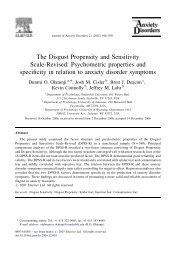The Yale-Brown Obsessive Compulsive Scale - University of ...
The Yale-Brown Obsessive Compulsive Scale - University of ...
The Yale-Brown Obsessive Compulsive Scale - University of ...
Create successful ePaper yourself
Turn your PDF publications into a flip-book with our unique Google optimized e-Paper software.
578 B.J. Deacon, J.S. Abramowitz / Anxiety Disorders 19 (2005) 573–585symptoms, administration <strong>of</strong> the Y-BOCS symptom checklist and severity scale,and the Mini International Neuropsychiatric Interview (MINI; Sheehan et al.,1998). Interviewers had received training in the administration <strong>of</strong> the Y-BOCSand MINI by attending a didactic seminar on these measures, observing theadministration <strong>of</strong> the measures by an experienced clinician, and then administeringthe measure under observation by a more experienced interviewer whoprovided constructive feedback. Although interrater reliability for the Y-BOCSand each primary diagnosis was not formally examined, all assessors met with thesecond author to discuss diagnostic impressions, case conceptualization, and t<strong>of</strong>ormulate treatment recommendations for each patient. Patients were onlyincluded in the present study if there was 100% interrater agreement on OCDas a primary diagnosis.2. Results2.1. Sample CharacteristicsPatients had a mean Y-BOCS severity score <strong>of</strong> 24.0 (S.D. ¼ 5.4) and a meanscore <strong>of</strong> 27.2 (S.D. ¼ 13.7) on the OCI-R indicating moderately severe OCDsymptoms. <strong>The</strong> mean BABS score was 8.2, (S.D. ¼ 4.7), indicating generallygood insight into the senselessness <strong>of</strong> OCD symptoms. Scores on the BDI(M ¼ 17.2, S.D. ¼ 10.8) and the SAS (M ¼ 40.5, S.D. ¼ 9.5) indicated moderatelevels <strong>of</strong> depression and state anxiety. Mean scores on the SDS work, social, andhome/family were (respectively) 5.9 (S.D. ¼ 3.0), 6.2 (S.D. ¼ 2.4), and 6.8(S.D. ¼ 2.5). <strong>The</strong> internal consistency <strong>of</strong> the Y-BOCS in the current samplewas .78.2.2. Confirmatory factor analysisUsing LISREL (Jöreskog & Sörbom, 1993) we tested the goodness-<strong>of</strong>-fit <strong>of</strong> allpreviously reported models <strong>of</strong> the Y-BOCS factor structure. All analyses wereconducted using maximum likelihood estimation and were computed from thecovariance matrix among the Y-BOCS items. Following Amir et al. (1997), weincluded five commonly used fit indices: (a) chi-square, (b) adjusted goodness <strong>of</strong>fit index (AGFI), (c) root mean square error <strong>of</strong> approximation (RMSEA), (d)comparative fit index (CFI), and (e) normed fit index (NFI). Following thesuggestions <strong>of</strong> numerous authors (e.g., McKay et al., 1995; Moritz et al.,2002), the residuals <strong>of</strong> question pairs (time, interference, distress, resistance,and control) were correlated in each model.Table 2 presents fit indices for the single factor model (Fals-Stewart, 1992),two-factor models (Amir et al., 1997; McKay et al., 1995, 1998), and three-factormodel (Kim et al., 1994; Moritz et al., 2002). As can be seen, none <strong>of</strong> these modelsprovided an adequate fit to the Y-BOCS data in the current sample. Chi-square




